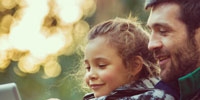
Providing a learning environment and the effects of this on the child's learning has been the subject of studies all around the world, as has the ways in which children learn, but does this mean that nature (the child’s own predisposed abilities) or nurture (the environment the child is in) is responsible for the child’s learning. These studies have lead to many findings, here are the most common findings that may help you determine which is truly effective…

Nature
vs Nurture
Providing a learning environment and the effects of this on the child's learning has been the subject of studies all around the world, as has the ways in which children learn, but does this mean that nature (the child’s own predisposed abilities) or nurture (the environment the child is in) is responsible for the child’s learning. These studies have lead to many findings, here are the most common findings that may help you determine which is truly effective…
Types of Learning

Children, especially young children, use methods of learning (that excludes emotions) to learn about the world around them. Statistical learning, learning through imitation and analogy/casual learning are the main forms in early childhood. Older children and young adults that have developed emotional capabilities and intelligence and can learn through emotive methods as well as the types of learning they were ‘born with’.
Learning Triggers

There are many ‘reminders’, ‘triggers’ or ‘cues’ created in our environments (even down to seeing particular brand logos in the street), which can be manufactured by teachers in the classroom. How many classrooms have you seen with displays on walls surrounding particular subjects? These displays are meant to make an imprint on a child’s subconscious helping them to learn what is displayed, as well as act as reminders. Reinforcing this knowledge increases the chances of the information being taken on board and ‘learnt’ by the child thus falls into the 'Nurture' category.
Natural Ability

It is well established that each child has their own unique, ‘natural’ abilities, for example, some children are predisposed to perform well in sports, whilst others are predisposed to achieve academic greatness, just like some children are born ‘visual’ learners, whilst others learn through ‘auditory' techniques. These abilities can be developed and honed through practice but are almost always built on abilities they are ‘born with’, thus falling into the category of 'Nature' but can be manipulated by 'Nurture'.
Repetition & Association

All teachers (and all adults for that matter), know that if you repeat something enough times it will ‘stick’, taking it from information, to memory, to eventually knowledge. We all know that little techniques such as colour-coding or assigning something familiar to something unfamiliar, can have the same effect. This way of learning means that ‘nature’ i.e. techniques we fabricate in order to develop our knowledge, can be manipulated to build on elements of what we already know (nurture).
Visuals

Much like how a memory works, we can remember where we were when something significant took place thanks to visual imprints. Certain colours of walls, furniture, rooms, and landscapes can help us to recall something that we once 'learnt'. This can be taken as far as remembering where we were sat, what we were wearing, what we were listening to or eating/drinking at the time, meaning all of these attributes can then help us to recall something connected, should we encounter them again. This has been developed into another theory of learning that you may have heard of.
This theory suggests that if you chew gum whilst reading a text book, if you then chew gum during an exam on that text book, you are more likely to recall the information, much like triggers. Suggesting an understanding of your environment can benefit you if used in an effective way. In classrooms, this may be sitting in the same classroom chair throughout the school year, and then taking an end of year exam in that same spot.
Focus

In order to learn, there is usually some element of focus, whether this be natural focus (i.e. when paying attention to something that genuinely interests you) or unnatural focus (when forcing yourself to learn something
that you wouldn’t normally encounter to achieve a goal). The first of these types, natural focus, is descriptive of 'nature', what is already interesting to you is more likely to be absorbed easily. However, focus can be manipulated. In a classroom, having too many displays, pictures, bright colours etc, can distract from the subject in hand, altering the level of focus. Other colours can be uplifting emotionally and behaviourally, meaning the environment is enjoyable, thus information is more likely to be absorbed as this sort of environment is imitating the natural interest, through. Bright lights can wake students up, but also aggravate their eyesight, whilst dull lighting can have the opposite effect. Too much sound can distract, but too little (i.e. silence) can create an element of boredom. All of this suggests that the nurturing of an environment can be responsible for how the child’s ‘nature’ works.
The Final Word
After reviewing many theories on the nature vs nurture topic, it can be derived that one predisposes a child to learning, whilst the other harnesses the
child’s natural abilities, builds on them and subsequently develops their ‘not-so-natural’ abilities to create an overall level of learning and knowledge. This can be beneficial in a classroom as through the decoration, layout, sounds,classroom furniture etc. a teacher can create a learning environment that is optimised to
help the majority learn a little easier.